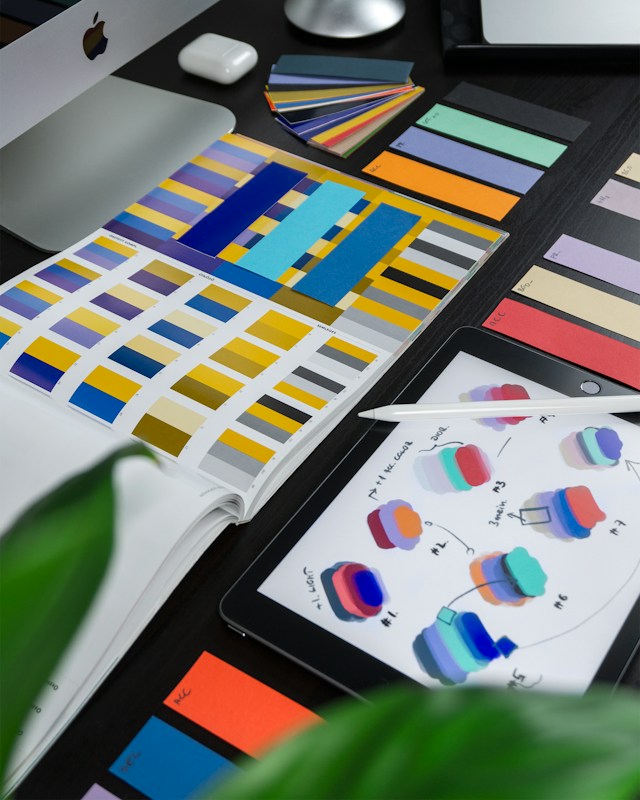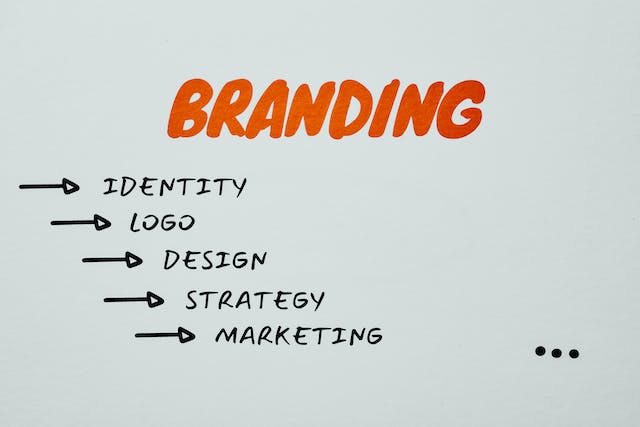You probably have a good idea of what a brand is. However, you may have never thought about the process of designing a brand. There’s also the not-so-small matter of how to share this branding with your audience. So, what is brand design? How can companies create an image and convey a message effectively? And how does this fit with UX/UI?
Here’s everything you need to know.

What Is Brand Design?
Firstly, what is branding design? Essentially, it refers to any visual representation of your company. This includes all the touchpoints where you show up for your audience, from social media to business cards.
Your brand design shows off your company’s personality and ethos through aesthetics. In fact, it’s a crucial part of your business strategy because it can enhance recognition and customer loyalty.
According to the US Chamber of Commerce, over half (55%) of brand first impressions are visual. Plus, research indicates that consumers are 81% more likely to remember a brand’s color scheme than its name.
These stats speak for themselves: branding is crucial.

What’s Included in Brand Design?
Branding encompasses a wide range of things. More specifically, branding design concerns all the visual elements of a brand.
Logo
The logo is one of the most crucial pieces of artwork. It projects the company’s entire ethos at just a glance. Even new customers will see your logo, so it’s important that it speaks to your target market.
Text
All text elements, called typography, are crucial. Each font has unique design elements that create a different aesthetic. So, while script-style fonts make brands feel personal (and often feminine), serif fonts can add a timeless, classic feel.
Colors
According to Website Planet, 40% of Fortune 500 companies use blue in their logo. Why? Well, simply put, it’s because the color scheme is an essential part of branding. The right color can easily help you reach your target audience.
Webflow suggests that there’s even a generational divide between color schemes. As a result, you can target your audience according to age, gender, and more with the right color.
Icons and Illustrations
Most companies have a lot of imagery. This includes all images across your website and socials, the iconography of the website, and any illustrations. Depending on your industry, there may even be graphs and data visualizations to contend with.
Icons can be unique to your brand, but they should always be understandable to your audience. Similarly, all illustrations should add to your brand aesthetic and reach your target audience. A consistent style will help you forge an identity that your customers resonate with and remember.

How To Create a Brand Identity
Next, you need to know how to create a brand identity. It’s not as easy as throwing a dart at a list of fonts and choosing the one it lands on. Instead, you need to carefully consider what your target audience wants.
1. Research Carefully
Crucially, you need to research before you begin. There are two types of research: customer research and market research. Both are equally important. For UX and UI designers, there may be specific ways you can research (more on this later).
Generally, you need to find out what your target demographic likes. What colors, fonts, and imagery do they prefer?
Then, take a look at your competitors. Is what they’re doing working, or is there something you can improve on?
2. Devise a Mission Statement
Next, you need a mission statement. This is a couple of sentences that explain what your brand’s purpose is.
For example, Sweetgreen’s mission statement is: “Building healthier communities by connecting people to real food.” This is simple, clear, and reaches the target audience.
Your mission statement should drive your visual identity. Sweetgreen, for example, plays on its themes of health and human connection with soft, rounded text and earthy green tones.
3. Create a Visual Identity and Style Guide
When you know who you’re trying to reach, you can create a style guide. Pull together all your market research and create your style guide. This should include colors, fonts, icons, and more. Throughout the process, ensure all the visual elements complement each other.
You should refer to your style guide every time you create branded content.

Nailing Your Brand Logo Design
Your logo is one of the key elements of your brand. If you don’t put enough thought into it, you’ll find yourself changing your logo again and again.
Your logo should capture the attention of your target audience. With strong branding, your company can become instantly recognizable to your loyal customers.
Brand logo design links strongly to UX and UI. Much like UX, you should implement usability testing for your logo. For example, check:
- Size: How does the logo scale to different sizes for different purposes?
- Shape: Is the logo fit for different purposes, such as websites, merchandise, and business cards?
- Color: Is the color transferable to different mediums? What happens if someone prints the logo in black and white?
In this way, your logo is like any UI design element. You must carefully check that it works for your users and that it tests well.
How To Translate Branding into UI/UX
Branding is an important but often overlooked part of UX. So, you need to know how to translate branding into UI/UX.
When designing digital products, branding is just as crucial as it is elsewhere. What is branding in design for digital products? Fundamentally, branding design here refers to all the visual elements of a website, app, or software. As a result, UI is a crucial part of it.
The UI interacts visually with the users, with underlying branding there to support it. Meanwhile, the branding design creates better UX because the user knows exactly what the company is about at a glance. UX, UI, and branding design are all forms of storytelling and ways of conveying your company’s message.
When you know what you want your branding to look like, you can incorporate it into the design process. Here’s how.
- Use the color palette, font, and iconography of your style guide throughout the digital product.
- Maintain the same consistency across all marketing materials, including social media, physical materials, and the website.
- Employ consistent language in your UX copy, ensuring that the tone you use reflects the personality of your brand.

Why Is Brand Design Important for UX/UI?
By taking the above steps, you can create better brand loyalty. Users will feel this consistency throughout the product, making them feel secure. Plus, if your branding is right, it provides the audience with what they need at every touchpoint.
After all, the aim of marketing is usually to sell a lifestyle, not a product. With consistent branding, you can create this lifestyle for users to aspire to. As a result, they’ll feel confident in your product’s ability to achieve it.
Combining UX and UI with branding creates a cohesive experience that provides authenticity for the consumer. In many ways, branding is the core of UX/UI. It informs the identity that designers are trying to project.
Letting branding design inform UX and UI means that the user receives a great final product they’ll want to explore. Conversely, if the branding is incoherent, the user will become confused and frustrated. As a result, it damages the UX.
It’s always important to strive for consistency. With the right branding, your company voice will be authentic and trustworthy. In turn, you can attract and retain more customers.
Conducting Effective Brand Research for UX
As mentioned above, research is a crucial part of branding. After all, a strong identity design is impossible without knowing your consumer.
Fortunately, the field of UX also involves a great deal of research. UX researchers may already have the tools they need for effective brand research. Although UX research and market research differ, they can work together. Think of them like this:
- Market research: why and how consumers buy products.
- UX research: how users interact with a digital product.
Market research involves learning about the target audience, their pain points, and their goals. It often involves large-scale surveys and data analysis. Researchers aim to find out if there is a market for the product in question. It can also help companies decide on their price point, marketing budget, and more.
Meanwhile, UX research involves studying user behaviors. It’s more specific than market research because it pertains only to digital products. UX researchers look into their audience, including their pain points and goals, but also behavior. They use this information to make the product more user-centric and functional.
UX research, like market research, involves surveys. However, it also uses methods like contextual inquiries, card sorting, and affinity mapping. The idea is to create a product that users love and can make the most of. As a result, the research questions are often things like:
- How and when do customers use this product?
- What issues do users encounter when using this product?
- Where does the product fail to meet the users’ needs?
- Is there a better way to do this function that makes the users’ lives easier?
The best way to do brand research for UX/UI is to do a mixture of market research and UX research. That way, you cover all the bases and can build an effective product that helps users achieve their goals.

Iterative Branding for UX/UI
UX and UI are iterative processes, which means that they need constant refinement. Designers consistently review, test, and hone their designs to make them better. They update their products when new technology arises, when consumer preferences change, and so on. They also update according to user feedback.
Branding is also not static. Your consumer preferences are subject to change with current trends or as they grow older. As a result, brand designers need to keep on their toes. Whenever faced with user feedback or new market research, you need to be able to adapt.
Ideally, your branding should not change too often. This can be confusing and can damage brand loyalty. However, it’s also not something that you can set and forget. Sometimes, there’s a need for a branding overhaul. Where possible, though, try to change as little as possible about your branding.
If you have done your research correctly, you should be able to create a brand that speaks to your audience. In theory, this shouldn’t change too much. Just keep honing your product to solve their pain points, and you can build solid brand loyalty.
Discover the Best Branding Examples in UX/UI
In short, what is brand design, and how does it relate to UX? Branding is all about the visual elements you use to convey a message. User interface design is inherently about these same visuals. But branding is also about creating an experience (or a lifestyle) for the consumer. This is an integral part of UX. By making UX, UI, and brand design work together, you can build a strong product that consumers will love.
If you’re looking for more design inspiration, why not learn from proven products? Page Flows is a helpful resource for finding interaction design ideas. Get started today to view a library of user flow recordings and stay up-to-date with design trends..





